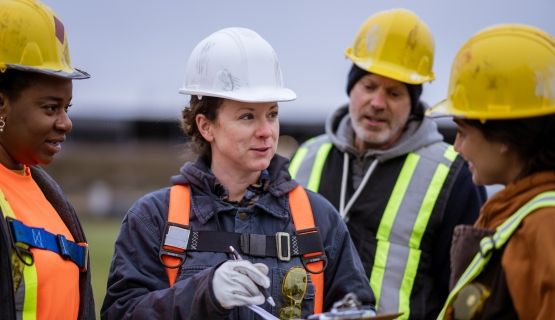Illness/injury prevention
IWH has a long history of conducting research to provide practical guidance to employers, workers, OHS professionals and regulators about what works and what doesn’t in injury or illness prevention. This research targets the injury and illness prevention practices of workplaces, as well as the programs developed by governments, health and safety associations and others to support and motivate workplaces to adopt effective practices.
Featured

At Work article
Differences in firm-level AI use for health and safety
To what extent are Canadian workplaces using artificial intelligence (AI) to help support workers’ health and safety? And what do these workplaces have in common? An IWH study surveyed firms across Ontario and British Columbia to find out.
Published: October 8, 2025

Impact case study
Saskatchewan’s construction safety group uses IWH tool to improve safety culture
This case study details how the Saskatchewan Construction Safety Association (SCSA) members have been analyzing IWH-OPM scores to adjust their safety practices and how SCSA has been using the data to tailor their outreach.
Published: February 10, 2025

IWH in the media
Inquest witness pressed on Working at Heights training outcomes
Testimony from a senior Ministry of Labour, Training and Skills Development (MOL) policy manager on day three of Ontario’s swing stage inquest Feb. 2 revealed the ministry may be recommending changes to Working at Heights (WAH) training as soon as April. Don Wall reports.
Published: Daily Commercial News, February 2022
Journal article
Journal article
Unionisation and injury risk in construction: a replication study
Published: Occupational & Environmental Medicine, January 2022
Project
Project
Trends in the severity of work-related injury in Ontario
IWH is developing a method to classify the severity of work-related injuries presenting to hospital emergency departments.
Status: Ongoing
Journal article
Journal article
The prevalence and correlates of workplace infection control practices in Canada between July and September 2020
Published: Health Reports, November 2021
Journal article
Journal article
Implementation of participatory organizational change in long term care to improve safety
Published: Journal of Safety Research, September 2021

At Work article
What research can do: Partnering on a tool to estimate occupational risks of COVID
Public Health Ontario and Institute for Work & Health collaborate on a tool to estimate the occupational exposures that put workers at risk of COVID-19
Published: August 2021

At Work article
Inadequate employment standards, OHS vulnerability add to higher injury risks
IWH researchers found workers whose jobs fail to offer minimum employment standards are at an increased risk of work injury. When these workers also face health and safety vulnerability on the job, their risk of injury is even higher than the combined risk.
Published: August 2021

IWH in the media
Work-related skin cancer among construction workers set to double by 2060
Cases of work-related non-melanoma skin cancer among construction workers in Ontario are on track to double by 2060. However, according to new research done by the Institute for Work & Health (IWH), if protective equipment and clothing such as long-sleeve shirts, pants and neck coverings are worn by construction workers, up to 6,034 cases of such cancers could be averted over the next three decades. That would result in $38 million in costs (in 2017 Canadian dollars) being saved over a 30-year period, Grant Cameron reports.
Published: Daily Commercial News, July 2021
IWH Speaker Series
IWH Speaker Series
What can hospital emergency records tell us about the incidence of work-related traumatic injuries in Ontario?
Every year, hospital emergency departments in Ontario treat an average of 100,000 cases of work-related injuries or illnesses. What can the records of these cases tell us about the reporting of work-related injuries and illnesses to Ontario’s Workplace Safety and Insurance Board (WSIB)? In this presentation, Dr. Cameron Mustard shares findings from research comparing WSIB claims data with records of hospital emergency department visits over a fifteen-year period (2004-2017).
Published: June 2021

At Work article
Weaker OHS procedures, policies explain small employers’ higher injury risks: study
Workers at small firms are more exposed to hazards and report more work-related injuries and illnesses. But an IWH study finds injury risks in large and small firms even out when weaker OHS policies at small firms are accounted for.
Published: May 2021